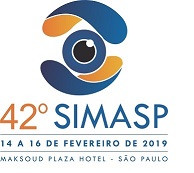Dados do Trabalho
Título
CHORIOCAPILLARIS AND RETINAL VASCULAR PLEXUS DENSITY OF DIABETIC EYES USING SPLIT-SPECTRUM AMPLITUDE DECORRELATION SPECTRAL DOMAIN OPTICAL COHERENCE TOMOGRAPHY ANGIOGRAPHY
Introdução
Split-spectrum amplitude decorrelation angiography (SSADA) for spectral domain optical coherence tomography (SD-OCT) has enabled detailed, non-invasive assessment of vascular flow. This study evaluates choriocapillaris and retinal capillary perfusion density (CPD) in diabetic eyes using OCT angiography (OCTA).
Métodos
Records of 113eyes that underwent OCTA imaging at a single institution were reviewed. Eyes were grouped as non-diabetic controls (37 eyes), patients with diabetes mellitus (DM) without diabetic retinopathy (DM without DR, 31 eyes), non-proliferative diabetic retinopathy (NPDR, 41 eyes), and proliferative diabetic retinopathy (PDR, 26 eyes). Quantitative CPD analyses were performed on OCTA images for assessing perfusion density of the choriocapillaris and retinal plexus for all patients and compared between groups.
Resultados
Eyes with NPDR and PDR showed significantly decreased choriocapillaris CPD compared to controls, while DM eyes without DR did not show significant change. Choriocapillaris whole image CPD was decreased by 8.3% in eyes with NPDR (p<0.01) and decreased by 7.1% in eyes with PDR (p<0.01). Choriocapillaris parafoveal CPD was decreased by 8.9% in eyes with NPDR (p<0.01), and decreased by 8.2% in eyes with PDR (p<0.01). Compared to controls, only eyes with PDR showed significantly decreased retinal CPD, as well as significantly increased foveal avascular zone (FAZ) area. In those patients, retinal whole image CPD was decreased by 9.7% (p<0.01), retinal foveal CPD was decreased by 20.5% (p<0.01), and retinal parafoveal CPD was decreased by 11.4% (p<0.01). FAZ area was increased by 50.9% (p<0.01).
Conclusões
Choriocapillaris and retinal CPD are reduced in diabetic retinopathy, while foveal avascular zone area is increased in eyes with PDR. Vascular changes captured by new imaging modalities can further characterize diabetic choroidopathy. In conslusion, this study showed that OCTA is capable of detecting capillary perfusion changes in the retina and choriocapillaris of diabetic patients compared to healthy individuals as well as correlating these capillary density changes with the ocular disease severity.
Palavras Chave
diabetic, retinopathy, choroidopathy, Optical coherence tomography, angiography.
Arquivos
Área
Retina
Instituições
UNIFESP-EPM - São Paulo - Brasil
Autores
Felipe F Conti, Eduardo B. Rodrigues
